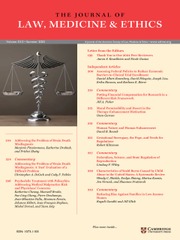No CrossRef data available.
Article contents
Systematic Reviewers Have an Obligation to Promote Research Integrity
Published online by Cambridge University Press: 14 April 2025
Abstract
Systematic reviewers are ideally placed to detect untrustworthy studies and decrease their use in decision making. The systematic review process already requires rigorous evaluation of an entire body of evidence related to a particular question. Excluding untrustworthy studies from systematic reviews can reduce their subsequent impact on evidence used for decisions and raise awareness of the problem among universities, journal editors, research funders and other stakeholders who can take appropriate action to eliminate them from the scientific literature.
Keywords
- Type
- Symposium
- Information
- Copyright
- © The Author(s), 2025. Published by Cambridge University Press on behalf of American Society of Law, Medicine & Ethics


